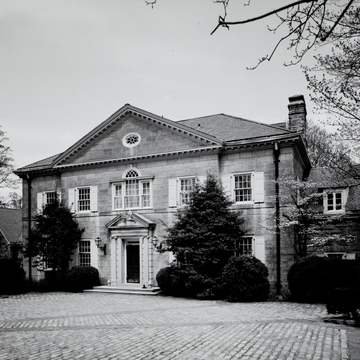You are here
1266 Loudon Heights Road (Chilton House)
This magnificent stone mansion, designed by a master of the mature Georgian Revival style, is the cream of the South Hills architectural crop. Stylistically, the Chilton House relates to a number of Bottomley's houses in Richmond, Virginia, but it differs from them in being built of stone, quarried nearby, rather than of brick. The entrance facade is centered with a threebay, pedimented pavilion that projects slightly from the end bays. Beyond, hyphens connect to asymmetrically matched wings. The central block is of smooth ashlar; the dependencies are of rough-faced stone. The carefully integrated landscape plan includes a forecourt paved with Belgian block taken from the streets of Philadelphia. The Neo-Georgian interior woodwork is exquisitely rendered, and rooms are furnished accordingly.
Mr. and Mrs. William E. Chilton II, both from long-established Charleston families, commissioned the house. Mrs. Chilton, née Nancy Ruffner, had commissioned Bottomley to design another house (unbuilt) before she was married. The original blueprints, as well as correspondence between the client and the architect, remain to provide a complete record of the design process and construction history.
The house, which is referred to by its address, is not visible from Loudon Heights Road, but may be glimpsed from Wildacre Road. Wildacre, developed on property formerly part of the Chilton estate, is a small, late-twentiethcentury subdivision accessed from the same entranceway off Loudon Heights Road as the drive to the house.
Writing Credits
If SAH Archipedia has been useful to you, please consider supporting it.
SAH Archipedia tells the story of the United States through its buildings, landscapes, and cities. This freely available resource empowers the public with authoritative knowledge that deepens their understanding and appreciation of the built environment. But the Society of Architectural Historians, which created SAH Archipedia with University of Virginia Press, needs your support to maintain the high-caliber research, writing, photography, cartography, editing, design, and programming that make SAH Archipedia a trusted online resource available to all who value the history of place, heritage tourism, and learning.

